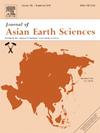中国大唐坡型锰矿床含锰流体底辟—排泄构造体系研究
IF 2.4
3区 地球科学
Q2 GEOSCIENCES, MULTIDISCIPLINARY
引用次数: 0
摘要
中国大塘坡型锰矿床是一种独特的锰矿床类型,即沉积型喷淋型锰矿床。这些矿床主要分布在新元古代南华裂谷武陵次级裂谷的次级地堑中,具有含锰流体底辟-排泄构造体系的特征。现场观察发现,从基底向上,这些沉积物中有四种结构类型:穹状脊、泥底喷流柱、树突状射流管和扇形上升流线。这些相互连接的构造形成了一个完整的浅层底辟-排泄系统。对其结构形态、物质组成、运动学和动力学特征的详细研究表明,锰的来源主要是深部含锰流体。多期次的流体底辟和排放形成了多套底辟-排放体系,这些体系可能出现在不同的地层层位上,也可能在同一层位内重叠转化。识别此类流体底辟—排放系统对于认识中国大塘坡型锰矿床的成矿机制具有重要意义。本文章由计算机程序翻译,如有差异,请以英文原文为准。

A study on the Manganese-Bearing fluid Diapir–Discharge structural system of the Datangpo-Type manganese deposits in China
The Datangpo-type manganese deposits in China represent a distinct category of manganese deposits, i.e., sedimentary exhalative manganese deposits. These deposits, distributed predominantly across secondary grabens in the Wuling secondary rift within the Neoproterozoic Nanhua Rift, are characterized by a manganese-bearing fluid diapir–discharge structural system. Field observations identified four structural types within these deposits from the base upward: domal ridges, mud diapir columns, dendritic jet-flow tubes, and fan-shaped upwelling lineations. These interconnected structures form a complete shallow-level diapir–discharge system. Detailed studies of the structural morphology, material composition, and kinematic and dynamic features revealed that the source of the manganese is predominantly deep-seated manganese-bearing fluids. Multiple stages of fluid diapirs and discharges have produced several sets of diapir–discharge systems, which might occur across different stratigraphic horizons or overlap and transform within the same horizon. Identification of such fluid diapir–discharge systems is critical for understanding the metallogenic mechanisms of Datangpo-type manganese deposits in China.
求助全文
通过发布文献求助,成功后即可免费获取论文全文。
去求助
来源期刊

Journal of Asian Earth Sciences
地学-地球科学综合
CiteScore
5.90
自引率
10.00%
发文量
324
审稿时长
71 days
期刊介绍:
Journal of Asian Earth Sciences has an open access mirror journal Journal of Asian Earth Sciences: X, sharing the same aims and scope, editorial team, submission system and rigorous peer review.
The Journal of Asian Earth Sciences is an international interdisciplinary journal devoted to all aspects of research related to the solid Earth Sciences of Asia. The Journal publishes high quality, peer-reviewed scientific papers on the regional geology, tectonics, geochemistry and geophysics of Asia. It will be devoted primarily to research papers but short communications relating to new developments of broad interest, reviews and book reviews will also be included. Papers must have international appeal and should present work of more than local significance.
The scope includes deep processes of the Asian continent and its adjacent oceans; seismology and earthquakes; orogeny, magmatism, metamorphism and volcanism; growth, deformation and destruction of the Asian crust; crust-mantle interaction; evolution of life (early life, biostratigraphy, biogeography and mass-extinction); fluids, fluxes and reservoirs of mineral and energy resources; surface processes (weathering, erosion, transport and deposition of sediments) and resulting geomorphology; and the response of the Earth to global climate change as viewed within the Asian continent and surrounding oceans.
 求助内容:
求助内容: 应助结果提醒方式:
应助结果提醒方式:


